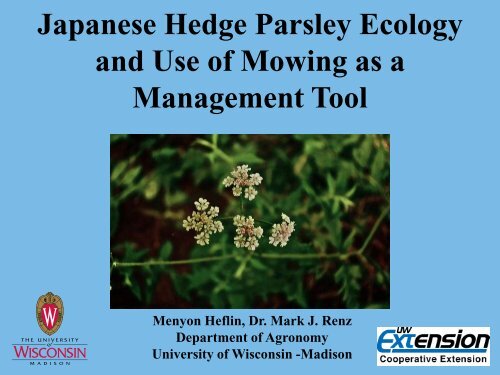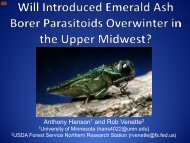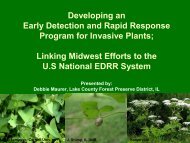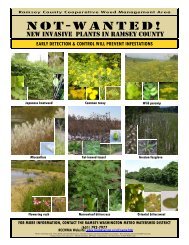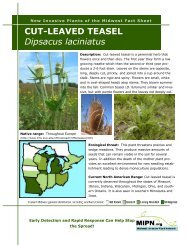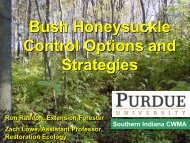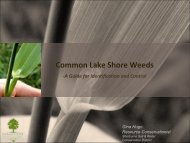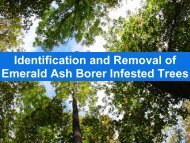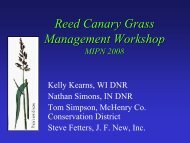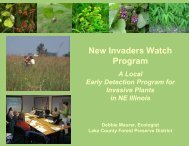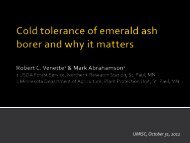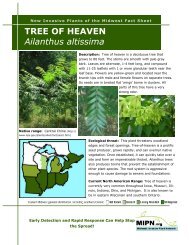Japanese Hedge Parsley Ecology and Use of Mowing as a ...
Japanese Hedge Parsley Ecology and Use of Mowing as a ...
Japanese Hedge Parsley Ecology and Use of Mowing as a ...
- No tags were found...
Create successful ePaper yourself
Turn your PDF publications into a flip-book with our unique Google optimized e-Paper software.
<strong>Japanese</strong> <strong>Hedge</strong> <strong>Parsley</strong> <strong>Ecology</strong><strong>and</strong> <strong>Use</strong> <strong>of</strong> <strong>Mowing</strong> <strong>as</strong> aManagement ToolMenyon Heflin, Dr. Mark J. RenzDepartment <strong>of</strong> AgronomyUniversity <strong>of</strong> Wisconsin -Madison
<strong>Japanese</strong> <strong>Hedge</strong> <strong>Parsley</strong>• New <strong>and</strong> problematic invader• Rapidly spreading• Diverse array <strong>of</strong> habitats
<strong>Japanese</strong> <strong>Hedge</strong> <strong>Parsley</strong> DistributionU.S. <strong>and</strong> Canada Distribution <strong>of</strong><strong>Japanese</strong> <strong>Hedge</strong> <strong>Parsley</strong>Known Wisconsin <strong>Japanese</strong><strong>Hedge</strong> <strong>Parsley</strong> Distributionhttp://plants.usda.gov/java/pr<strong>of</strong>ile?symbol=TOJAhttp://www.uwgb.edu/biodiversity/herbarium/inv<strong>as</strong>ive_species/torjap01.htm
Legal Context for ManagementWI DNR Chapter NR 40Inv<strong>as</strong>ive Species Identification, Cl<strong>as</strong>sification,<strong>and</strong> Control- Penalizes the intentional spread <strong>of</strong> seed- Requires management in some are<strong>as</strong>Image fromhttp://www.tnj.com/images/page_image/Gavels.jp
Legal Context: NR 40 SpeciesCl<strong>as</strong>sificationProhibited Species• Not present in an area or present insmall populations only• DNR may order controlRestricted Species• Too widespread/populations too large tocompletely eradicateImage fromhttp://dnr.wi.gov/wnrmag/html/supps/1999/oct99/time.htm• Control is highly encouraged, but not legallyrequired
NR40 Cl<strong>as</strong>sification in WIRed = ProhibitedOrange = RestrictedImage from http://dnr.wi.gov/inv<strong>as</strong>ives/
<strong>Mowing</strong>- Can be an effective management tool- However, timing MUST be correctImage from http://www.catskillhouse.us/blog/wp-content/uploads/2007/05/toro-model-20071-65-ph-22-inch-mower.jpg
Objectives• To determine whether mowing can effectivelycontrol <strong>Japanese</strong> hedge parsleyHypothesis: Yes, it can.• To determine the proper time to mow to preventthe production & spread <strong>of</strong> viable seedHypothesis: Flower bud to floweringstage
MethodsSampling Site DescriptionsSite Name Site Location ExperimentalDesignBike PathPle<strong>as</strong>ant ValleySpring GreenMadison, DaneCounty, WITown <strong>of</strong>Vermont, DaneCounty, WISpring Green,Iowa County,WISamples perTreatmentSiteDescriptionCRD 20 Popular urbanbike/pedestrianpathCRD 20 Wooded hilltopoverlookingprairie/savannaat natureconservancyRCBD 55 Alongfirebreakseither in forestor borderingrestored prairie
General Methods• Sampled 5 timesthroughout the summer• Plants were r<strong>and</strong>omlysampled along atransect.• Individuals were cut at 3in.• All biom<strong>as</strong>s above 3 in.w<strong>as</strong> removed.Ple<strong>as</strong>ant Valley, Spring 2011Bike Path, Spring 2011
Me<strong>as</strong>urements & AnalysesData Collected:• Phenology• Number <strong>of</strong> seedsproduced• SurvivalStatistical Analyses:• Kruskal-Wallis, Wilcoxon1-sample, & Wilcoxonrank-sum tests for seedproduction• Kruskal-Wallis rank-sumfor survival dataSpring Green, Various Blocks, Spring 2011
• No plants at any site resprouted in the spring <strong>of</strong> 2011.Objective 1: Can mowing effectively control<strong>Japanese</strong> hedge parsley?Survival ResultsPercentage <strong>of</strong> Plants with Additional Growth in Fall 2010Bike Path Ple<strong>as</strong>ant Valley Spring GreenEarly July 0 0 2Mid-July 0 0 0Early August 0 0 0Mid-August 0 0 4Late August/EarlySeptember5 0 0• There w<strong>as</strong> no significant difference between sites or treatment times in thepercentage<strong>of</strong> plants that had resprouted in the fall <strong>of</strong> 2010.
Percent <strong>of</strong> Sampled Plants with FruitsObjective 2: What is the proper time to mow toprevent the production & spread <strong>of</strong> viable seed?Phenology Results1009080706050403020100Percent <strong>of</strong> Plants with Fruit Present at Each Sampling TimeEarly July Mid-July Early August Mid-August LateAugust/EarlySeptemberSampling TimeSampling SiteBike PathPle<strong>as</strong>ant ValleySpring Green
Mean Number <strong>of</strong> SeedsObjective 2: What is the proper time to mow toprevent the production & spread <strong>of</strong> viable seed?Seed Production Results – Ple<strong>as</strong>ant Valley700600500Mean Number <strong>of</strong> Seeds per Sampling TimePle<strong>as</strong>ant ValleyCCC4003002001000BAEarly July Mid-July Early August Mid-August Early SeptemberSampling TimeDifferent letters indicate a significantly different mean number <strong>of</strong> seeds (p < 0.005).
Objective 2: What is the proper time to mow toprevent the production & spread <strong>of</strong> viable seed?Mean Number <strong>of</strong> SeedsSeed Production Results – Spring Green1200Mean Number <strong>of</strong> Seeds Per Sampling TimeSpring Green10008006004002000Early July Mid-July Early August Mid-August Late AugustSampling Time
Conclusions• To determine whether mowing can effectivelycontrol <strong>Japanese</strong> hedge parsley- Yes, mowing can kill <strong>Japanese</strong> hedgeparsley.• To determine the proper time to mow toprevent the production & spread <strong>of</strong> viable seed- Plants should be mowed in the flowerbud to flowering stage.
Implications• Phenology varies among urban <strong>and</strong> rural sites.- Urban sites exhibit earlier phenology.• Seed viability may vary among samplingtimes.• Microhabitat may also influence plantphenology, growth, <strong>and</strong> reproductive success.
Acknowledgements• My advisor: Dr. Mark Renz• Cooperating L<strong>and</strong> Managers/Owners: Tom & KathyBrock (Ple<strong>as</strong>ant Valley), Doug Lloyd & Laurie Derse(Spring Green), City <strong>of</strong> Madison, WI (Bike Path)• Undergraduate Students: Michelle Dobbratz , AsmaE<strong>as</strong>a, Brittney Janke, Lanette Martell• Other Field Assistance: Ryan DeRegnier, NoelleHarden, Mark Sieffert, Chris Stillion• Laboratory technicians: John Albright & BrendonPanke• CALS Lab Statistical Consulting: Nick Keuler• Funding: Science & Medicine Graduate ResearchScholars Community Advanced OpportunityFellowship, UW - Madison Dept. <strong>of</strong> Agronomy


